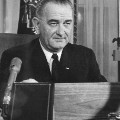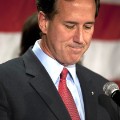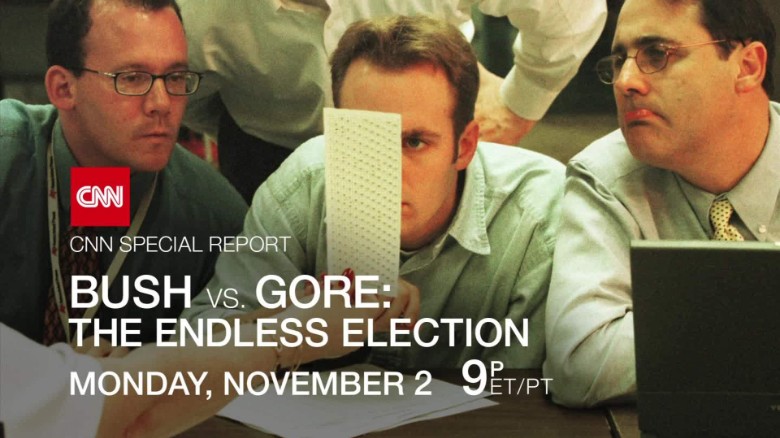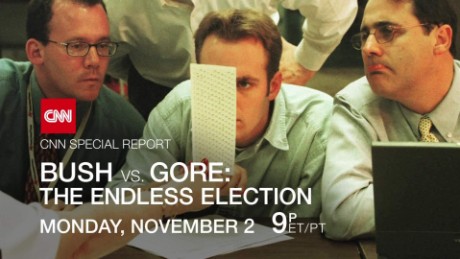"Bush's Toxic Legacy In Iraq"
Hans Blix' Fruitless Search For WMD And Bush/Cheney's Rush To War In Iraq
Cheney's Lucid 1994 Rationale For NOT Invading Iraq. Conservatives "Must" See This
"Bush's Toxic Legacy In Iraq"
Hans Blix' Fruitless Search For WMD And Bush/Cheney's Rush To War In Iraq
Cheney's Lucid 1994 Rationale For NOT Invading Iraq. Conservatives "Must" See This
"The Fall Of Iraq. Jawdropping Video Footage Of Cheney, Albright, Gen Clarke & Others"
So, who really won? What the Bush v. Gore studies showed
Story highlights
- As a whole, recount studies show Bush would have most likely won a Florida hand recount of undervotes. Alan: What do you know? Bush won... if you only recount certain votes. Duh.
- Studies also show Gore likely would have won a statewide recount of all undervotes and overvotes
- CNN's Gloria Borger explores the 2000 election in a special report Monday at 9 p.m. ET
CNN Chief Political Analyst Gloria Borger revisits the 2000 election in a CNN Special Report, "Bush v. Gore: The Endless Election," Monday at 9 p.m. ET.
(CNN)After the grueling 36-day Florida recount battle, Al Gore finally conceded the presidency to George W. Bush on December 13, 2000.
But the controversy surrounding this unprecedented election and its aftermath did not end there.
Months after the United States Supreme Court delivered its ruling to stop the statewide hand recount in the Sunshine State, media and academic organizations conducted their own studies of the disputed ballots in Florida.
Taken as a whole, the recount studies show Bush would have most likely won the Florida statewide hand recount of all undervotes. Undervotes are ballots that did not register a vote in the presidential race.
This goes against the belief that the U.S. Supreme Court handed the presidency to Bush, or took it away from Gore.
The studies also show that Gore likely would have won a statewide recount of all undervotes and overvotes, which are ballots that included multiple votes for president and were thus not counted at all. However, his legal team never pursued this action.
The studies also support the belief that more voters went to the polls in Florida on Election Day intending to vote for Gore than for Bush.
Even 15 years after the election, partisans on each side cherry-pick various scenarios that would have favored their candidate.
Here's a detailed look at what the studies found::
The first major review
The players: A group of newspapers including the USA Today, Miami Herald, and Knight Ridder newspapers conducted the first major review of the Florida ballots.
How it worked: The group hired the accounting firm BDO Seidman to examine more than 60,000 "undervotes" -- ballots that did not register a vote in the presidential race -- from all 67 Florida counties. These were ballots the Florida Supreme Court ordered to be hand counted with its December 8, 2000, decision.
The newspapers applied BDO Seidman's findings to four vote-counting standards. This was published in April 2001.
The results: The study shows that Bush likely would have won the statewide recount of undervotes even if the U.S. Supreme Court had not intervened to stop the counting. It also reveals that, ironically, the most lenient standard of vote counting —advocated by Gore — gives Bush his biggest lead. However, USA Today cautioned that, "The study has limitations. There is variability in what different observers see on ballots. Election officials, who sorted the undervotes for examination and then handled them for the accountants' inspection, often did not provide exactly the same number of undervotes recorded on election night."
The details, with USA Today's original explanations of the different standards in parentheses:
- Lenient Standard: Bush +1,665 ("This standard, which was advocated by Gore, would count any alteration in a chad -- the small perforated box that is punched to cast a vote -- as evidence of a voter's intent. The alteration can range from a mere dimple, or indentation, in a chad to its removal. Contrary to Gore's hopes, the USA TODAY study reveals that this standard favors Bush and gives the Republican his biggest margin: 1,665 votes.")
- Palm Beach Standard: Bush +884 ("Palm Beach County election officials considered dimples as votes only if dimples were found in other races on the same ballot. They reasoned that a voter would demonstrate similar voting patterns on the ballot. This standard -- attacked by Republicans as arbitrary -- also gives Bush a win, by 884 votes, according to the USA TODAY review.")
- Two corner standard: Bush +363 ("Most states with well-defined rules say that a chad with two or more corners removed is a legal vote. Under this standard, Bush wins by 363.")
- Strict standard: Gore +3 ("This "clean punch" standard would only count fully removed chads as legal votes. The USA TODAY study shows that Gore would have won Florida by 3 votes if this standard were applied to undervotes.")
A larger review gives mixed results
The players: Roughly a month later, a larger consortium that included the above outlets plus a group of five Florida newspapers released its review of more than 171,000 disputed ballots. In addition to the undervotes, this study reviewed more than 111,000 overvotes -- ballots that included multiple votes for president and were thus not counted.
This study showed that Democratic voters were far more likely to make the mistake of casting an overvote than Republican voters. Gore was marked on 84,197 of the overvote ballots, compared to 37,731 for Bush. USA Today's headline at the time read, "Florida voter errors cost Gore the election."
How it worked: The newspapers tallied up the overvotes, and then used BDO Seidman's undervote counting to test similar scenarios.
The results: This study shows a less decisive result than the count of only undervotes. However, there was no way to correct the overvote mistakes once they were cast, and Gore's team never asked for a hand recount of overvotes during the contentious recount battle in Florida.
Nevertheless, the study does support the theory -- expressed to CNN by both Gore's Florida senior adviser Nick Baldick, and the Republican senior adviser to Katherine Harris, John "Mac" Stipanovich -- that more voters went to the polls in Florida intending to vote for Al Gore than for George Bush.
Above all, USA Today highlighted that its review revealed, "The American system of elections routinely fails to count hundreds of thousands of ballots because of errors by voters, confusing ballot instructions, poorly designed ballots, flawed voting and counting machines and the failure of election workers to adequately help voters."
The details, again with USA Today's explanations cited in parentheses:
- Lenient standard: Gore +332 ("One uses the most permissive definition of a vote. It counts chads that are merely dimpled or bear slight impressions. Under the "dimple standard," Gore would have won by 332 votes.")
- Palm Beach standard: Gore +242 ("The other standard counts dimples as votes only if dimples are found in other races on the same ballot. This is known as the "Palm Beach Standard" because that is the rule that county's elections board adopted to determine voter intent in the early hand recounts of the Florida vote. The board's theory was that if dimples appeared in other races, that most likely meant that the voter just didn't press hard enough. Under this standard Gore would have won by 242 votes.")
- Two corner standard: Bush +407 ("The most widely used rule — that at least two corners of a chad must be detached to count as votes — is used in many states, including California, Oregon, Washington and Michigan. Recounting by that standard, Bush would have won by 407 votes, narrower than his 537-vote official margin.")
- Strict standard: Bush +152 ("By the strictest standard — one that requires a completely clean punch for the vote to count — Bush would have won by 152 votes. Some cleanly punched ballots were disqualified by counting-machines because of glitches, such as two ballots sticking together.")
The Florida Ballots Project
The players: A national media consortium -- composed of CNN, The New York Times, The Wall Street Journal, The Tribune Company, The Washington Post, The Associated Press, The St. Petersburg Times, and The Palm Beach Post -- paid for the National Opinion Research Center, or NORC, at the University of Chicago to review 175,010 disputed Florida ballots -- 61,190 undervotes and 113,820 overvotes.
How it worked: NORC, a highly respected data and research organization, conducted the counting of ballots. Their goal was not to determine a winner, but to "examine the ballots to assess the relative reliability of the three major types of ballot systems used in Florida." Carefully vetted coders reviewed the ballots, and NORC's raw data is still available to the public online.
The study, released in November 2001, took place over 10 months and cost nearly $1 million. The Washington Post explained, "153 field workers spent 6,500 hours describing every dimple, chad, erasure and relevant marking. Typists entered 17.5 million pieces of information into Chicago computers."
The different media organizations applied NORC's raw data to several distinct recount scenarios.
The results: The two major conclusions here are that Gore likely would have won a hand recount of the statewide overvotes and undervotes -- which he never requested -- while Bush likely would have won the hand recount of undervotes ordered by the Florida Supreme Court, although by a smaller margin than the certified 537 vote difference.
A sampling of headlines from the time include "Florida Recounts Would Have Favored Bush, But Study Finds Gore Might Have Won Statewide Tally of all Uncounted Ballots," from The Washington Post, and "Study of Disputed Ballots Finds Justices Did Not Cast the Deciding Vote," from The New York Times.
However, as the Post concluded, "While these are fascinating findings, they do not represent a real-world situation. There was no set of circumstances in the fevered days after the election that would have produced a hand recount of all 175,000 overvotes and undervotes."
The study was also released two months after the September 11 terrorist attacks, when the nation's focus moved away from the controversial 2000 election to the more pressing War on Terror.
The details:
Full statewide review
- Standard for acceptable marks set by each county in their recount: Gore wins by 171
- Fully punched chads and limited marks on optical scan ballots: Gore wins by 115
- Any dimple or optical mark: Gore wins by 107
- One corner of chad detached or any optical mark: Gore wins by 60
Review of limited sets of ballots
- Requests for recounts in Volusia, Broward, Palm Beach, and Miami-Dade: Bush wins by 225
- Florida Supreme Court order for all undervotes statewide: Bush wins by 430
- Florida Supreme Court order, as being implemented by counties, some of whom refused and some counted overvotes and undervotes: Bush wins by 493

































No comments:
Post a Comment